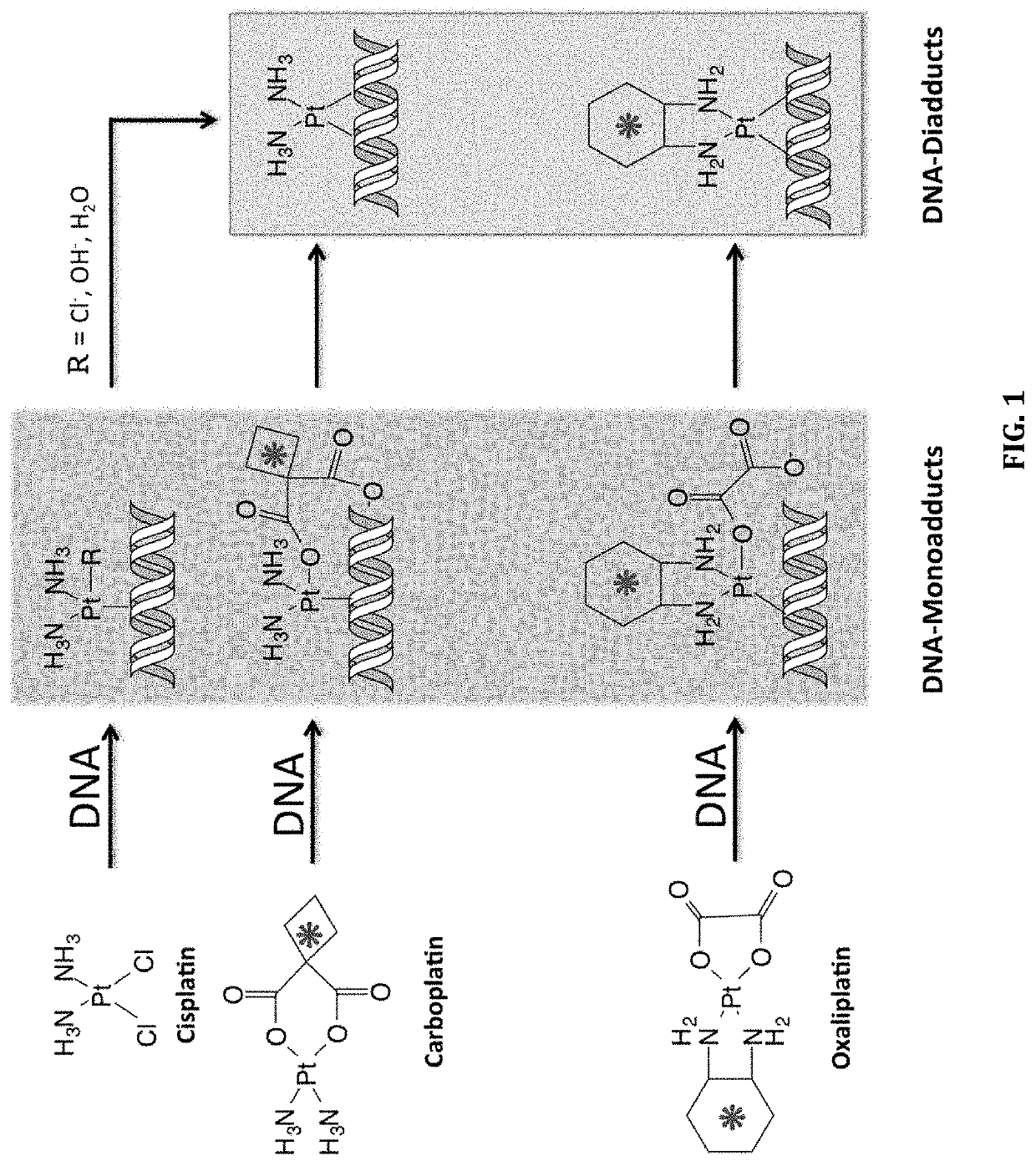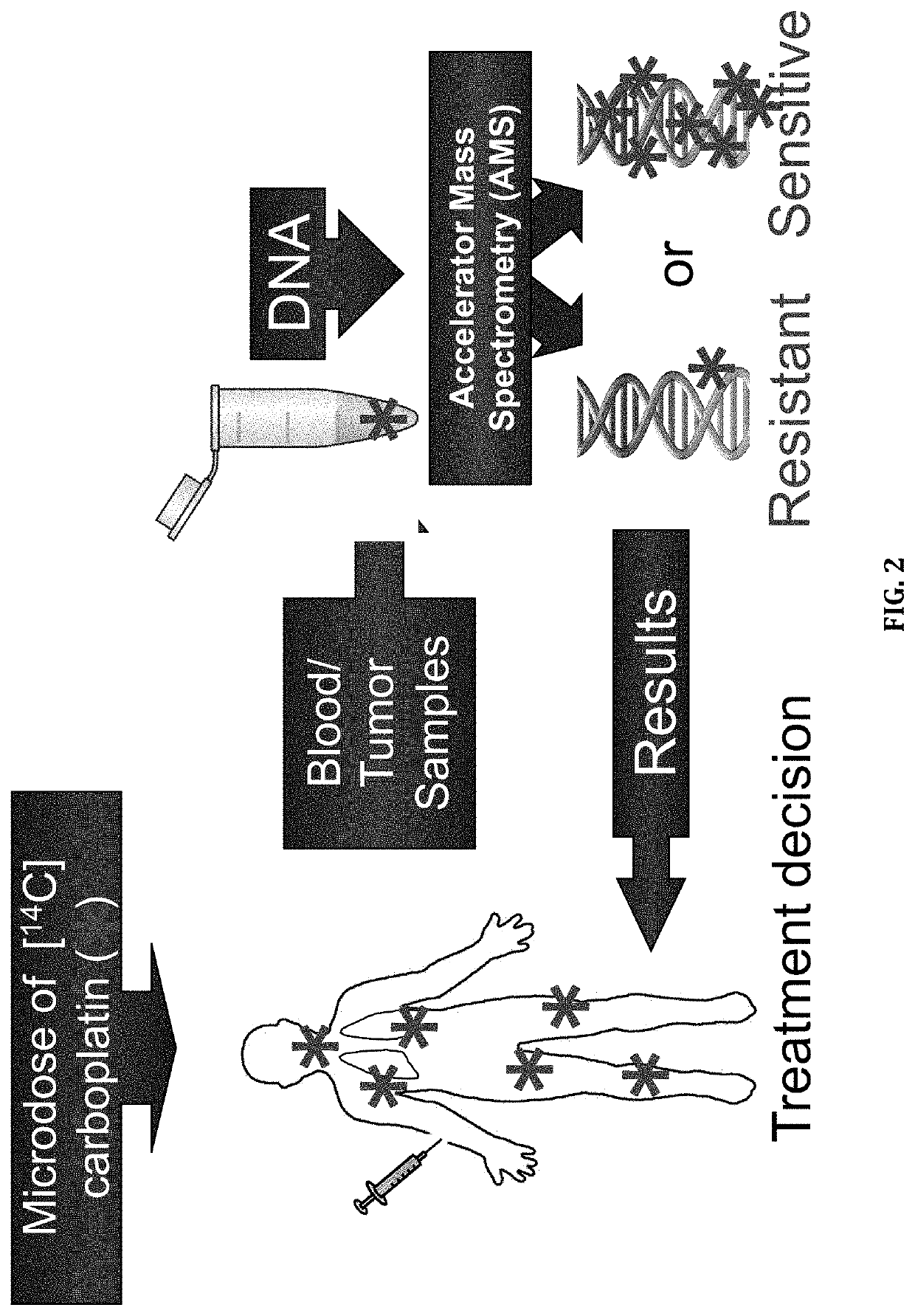Cytotoxic Chemotherapy-Based Predictive Assays for Acute Myeloid Leukemia
a technology of acute myeloid leukemia and cytotoxic chemotherapy, which is applied in the direction of biochemistry apparatus and processes, drug compositions, organic chemistry, etc., can solve the problems of insufficient patient response to chemotherapy, significant toxicity and therapy-related death rates, and less than 30% of patients
- Summary
- Abstract
- Description
- Claims
- Application Information
AI Technical Summary
Benefits of technology
Problems solved by technology
Method used
Image
Examples
example 1
Induced Carboplatin-DNA Monoadducts in Breast Cancer Cell Lines are Predictive of Carboplatin Cytotoxicity at Higher Concentrations
[0158]We determined if (1) microdoses of [14C]carboplatin can induce measurable carboplatin-DNA monoadducts in cell culture and (2) that levels of DNA monoadducts induced by relevant microdose concentrations are linearly proportional to the DNA damage caused by therapeutically relevant concentrations of carboplatin in breast cancer cells. A therapeutically relevant concentration used in cell culture experiments is the average maximum plasma drug concentration observed in humans that have been administered a therapeutic dose of drug. A relevant microdose concentration used in these cell culture experiments is 1% of the therapeutically relevant concentration.
[0159]Six breast cancer cell lines were tested. Carboplatin sensitive cell lines included Hs 578T (IC50=44 μM), MDA MB 468 (IC50=44 μM), and BT 549 (IC50=68 μM). Carboplatin resistant cell lines includ...
example 2
n of Carboplatin-DNA Monoadducts Induced by Microdose and Therapeutic Carboplatin Concentrations in Sensitive and Resistant Human NSCLC Cell Lines
[0164]Six non-small cell lung cancer (NSCLC) cell lines were treated in culture with [14C]carboplatin. Carboplatin-DNA monoadduct levels over time were determined by measuring 14C content in genomic DNA with accelerator mass spectrometry (AMS). Cellular sensitivity to carboplatin and cisplatin was analyzed by the MTT assay (Henderson et al., International Journal of Cancer 2011).
[0165]Human NSCLC cell lines H23, H460, H727, HCC827, H1975, and A549 were purchased from ATCC and were cultured with the recommended medium. The MTT assay was performed as previously reported to determine the drug concentration required to inhibit cell growth by 50% (IC50) of cisplatin and carboplatin. [14C]Carboplatin (at 53 mCi / mmol) was mixed with unlabeled carboplatin to achieve the specific activities required for microdoses and therapeutic doses. Table 1 lis...
example 3
on of Carboplatin-DNA Monoadduct Levels and Resistance to Both Carboplatin and Cisplatin Treatment
[0170]As shown in FIG. 1, cisplatin and carboplatin form the identical DNA diadduct structure. If these diadducts are the predominant DNA lesion responsible for cell death, then the IC50 of the two drugs should be linearly related. Thus, we measured the IC50 of the six NSCLC cell lines from Example 2 to both cisplatin and carboplatin to determine if the sensitivity of these six NSCLC cell lines to the two drugs are correlated. We observed a statistically significant linear correlation of the cytotoxicity of these two drugs in the 6 cell lines used in this study (R2=0.72, p=0.033, FIG. 9A) and also to six additional ATCC bladder cancer cell lines. (R2=0.72, p=0.033), FIG. 9B). The bladder cancer cell lines and their corresponding IC50 to cisplatin and carboplatin are shown in Table 2. This data further supports the notion that a [14C] carboplatin microdose diagnostic assay as described h...
PUM
| Property | Measurement | Unit |
|---|---|---|
| temperature | aaaaa | aaaaa |
| mass | aaaaa | aaaaa |
| time | aaaaa | aaaaa |
Abstract
Description
Claims
Application Information
 Login to View More
Login to View More - R&D
- Intellectual Property
- Life Sciences
- Materials
- Tech Scout
- Unparalleled Data Quality
- Higher Quality Content
- 60% Fewer Hallucinations
Browse by: Latest US Patents, China's latest patents, Technical Efficacy Thesaurus, Application Domain, Technology Topic, Popular Technical Reports.
© 2025 PatSnap. All rights reserved.Legal|Privacy policy|Modern Slavery Act Transparency Statement|Sitemap|About US| Contact US: help@patsnap.com



